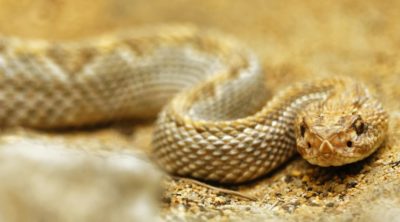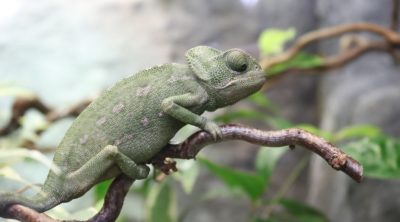
The green tree python is a very unique looking snake with many interesting characteristics. This article provides more facts.
The green tree python, scientific name Morelia virdis, is often confused with the emerald tree boa due the similarity in their sitting position. Both snakes coil around branches in a saddle fashion and rest their heads in the middle. Given below are some more facts.
Classification
- Phylum: Chordata
- Class: Reptilia
- Order: Squamata
- Family: Pythonidae
- Genus: Morelia
- Species: Morelia virdis
Appearance
As the name suggests, this python is green in color. It has a broken vertebral stripe that is white or dull-yellow in color. Some pythons also have blue, white, or yellow spots scattered over their body. Its length is between 1.6 m to 2.2 m (5 to 6 feet).
It has a slender body with a prehensile tail. This tail helps the snake move between tree branches. Its head is large, and it is wider than its body. The muzzle is angular. The snake has supralabial scales around its mouth with thermoreceptive pits. It spends most of its time over the tree branches in a coiled position with its head resting in the center of the coils.
Habitat
Its habitat includes tropical rainforests, swamps, and cultivated lands. It is found in the rainforests of New Guinea, Solomon Islands, and Aru Islands. It is also found in the very north of Australia.
Temperament
The temperament of this snake has earned it the reputation of being aggressive. Its temperament and behavior depends on the way it is treated. If you physically restrain the snake or treat it roughly, it is bound to turn aggressive and defensive. It will remain calm and gentle if you treat it in the opposite manner. However, this snake is not recommended as a pet for a beginner.
Behavior
This is mostly an arboreal snake that loves to while away its time curled up on tree branches. It spends the day hidden in safe areas on the ground and may even do some hunting during that time. It is a nocturnal creature, an aggressive hunter, and it uses its thermosensory pits to track the warm-blooded prey. It uses an interesting hunting strategy, wherein it wriggles its tail like a worm or small snake. This confuses birds and lizards and the snake attacks the prey by grabbing them from a distance. It has a wide jaw and enlarged front teeth that help it hold on to the fast-moving prey.
Diet
Its diet consists of small rodents and small mammals. It slithers through the forest decay using its sensory pits to hunt for food. It also eats birds, lizards, and other small reptiles. It manages to eat animals that are larger than its mouth size. It has very elastic jaw muscles that allow it to open its mouth more than its actual body size. It wraps several of its coils around the body of its prey till the prey suffocates to death.
Reproduction
This snake mates and lays eggs throughout the year. However, its breeding season is from August to December and the egg laying period is from November to February. The female lays her eggs in a tree hole or among the tree roots on the ground. She her coils around the eggs to raise the temperature with tiny muscle contractions. There are about 15 to 25 eggs laid in a nest. The hatchlings have various shades of yellow, red, or blue, with intermittent stripes and spots. These spots are all over the body and can be white, purple, brown, gold, or red in color.
Care Sheet
If you are keeping a green tree python as a pet, you need to keep it in an enclosure that will provide easy viewing. You can choose a front opening plastic or glass cage. You need to cover a portion of the screen top for maintaining the humidity levels. Hatchlings and juveniles can be kept in an enclosure that is 1 foot long, 1 foot wide, and 1 foot tall. An adult snake can be kept in an enclosure that is 2 feet long, 2 feet wide, and 2 feet tall.
You need to provide the snake with many branches and perches. Give it an option of multiple climbing branches that will keep it active The day temperature should be 86 to 88 degrees and the night temperature should be 78 to 80 degrees. Humidity should be about 40 to 70 percent. You should feed the hatchlings with a small mouse every five to seven days. The older juveniles and young adults should be fed with a hopper or medium-sized mouse every 7 to 10 days. Adults can be given 1 or 2 adult mice or a small rat every 10 to 14 days.
Interesting Facts
- The green tree python used to be classified under the genus Chondropython and it was the only member of the group.
- It has now been shifted to genus Morelia, making it share the group with many other Australian pythons.
- It is often called ‘Chondros’ as an abbreviation of its old genus.
- This snake is the best example of parallel evolution. It looks and behaves like the emerald tree boa of South America. However, the major difference between the two is, the emerald tree boa gives birth to live young and the green tree python lays eggs.
- Its hatchlings are bright-yellow, orange, or brick-red in color. They develop their distinct bright-green color after about 6 to 8 months.
The green tree python is popular among reptile collectors. It has been listed as a part of CITES Appendix II, which is an international treaty for restricting trade of the listed species.


